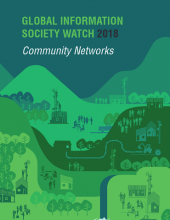2018 - Community Networks

This 2018 edition of GISWatch focuses primarily on community-owned networks for the provision of physical communications infrastructure.
Affordable and reliable internet access infrastructure has become a vital means of communication and access to information, to exercise fundamental human rights and to support economic, social and human development. However, as the internet becomes more ubiquitous, less is being heard from those who are unconnected –the less wealthy and more marginalised – who are unable to exercise their rights on the same footing. Those who do not have access are doubly excluded: excluded from the “new” world of information and communications that the internet delivers, and also excluded from the “old” analogue world they used to have access to – even if imperfectly – because so many of those services and opportunities are increasingly only available online. Ending digital exclusion is not simply a matter of improving the coverage of mobile broadband services, but also of improving the affordability and coverage of both fixed and mobile local network infrastructures and services, along with building the technical and human capacity to ensure reliability, the ability to deploy low-cost and open-access locally owned network infrastructures, and the ability to use the resulting connectivity in applications and content of local interest and benefit to local communities.
The 2018 edition of GISWatch focuses on local access models, specifically, community networks as self-organised, self-managed or locally developed solutions for local access, based on the conviction that one of the keys to affordable access is giving local people the skills and tools to solve their own connectivity challenges. Instead of buying an access service from a large corporate entity, community networks allow community members to self-provide and share infrastructure.
The 43 country reports included in this year's Global Information Society Watch (GISWatch) capture the different experiences and approaches in setting up community networks across the globe. They show that key ideas, such as participatory governance systems, community ownership and skills transfer, as well as the “do-it-yourself” spirit that drives community networks in many different contexts, are characteristics that lend them a shared purpose and approach.
The country reports are framed by eight thematic reports that deal with critical issues such as the regulatory framework necessary to support community networks, sustainability, local content, feminist infrastructure and community networks, and the importance of being aware of “community stories” and the power structures embedded in those stories.
Order a printed copy of the book
| Attachment | サイズ |
|---|---|
| GISWatch 2018 (English) | 12.8 MB |
| GISWatch 2018 Ebook (English - MOBI) | 6.04 MB |
| GISWatch 2018 Ebook (English - PUB) | 9.42 MB |